Best Baby Bottles for Breastfed Babies Who Refuse the Bottle (2025 Guide)
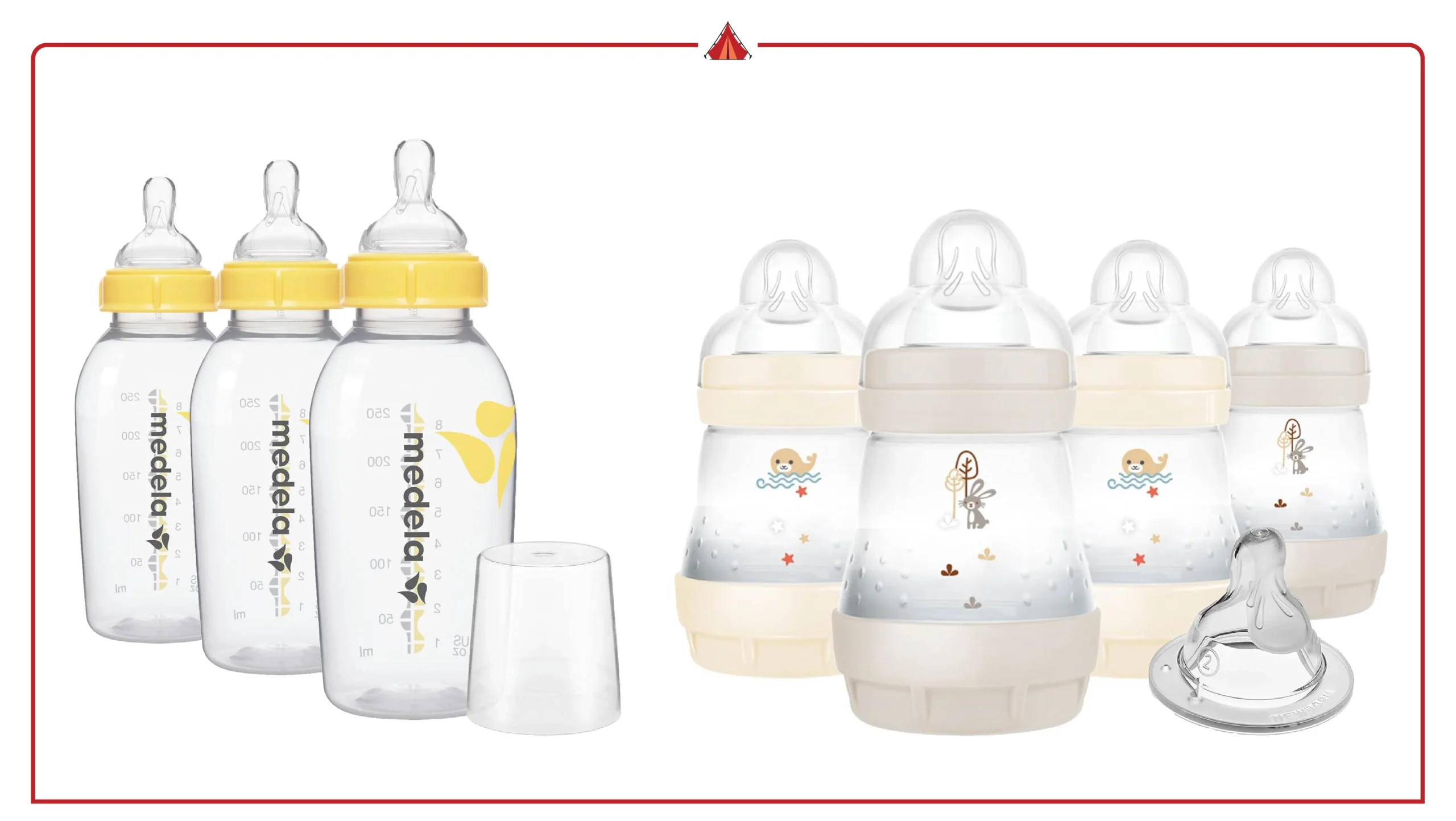
If you’re here, chances are you’ve reached that tricky stage where your little one flat-out refuses the bottle. It can feel stressful—especially if you’re heading back to work, need a break from breastfeeding, or simply want someone else to help with feeding. Many parents go through this, and the good news is that there are bottles designed to make the transition much easier.
The key is finding a bottle that feels and flows as close to breastfeeding as possible. The right nipple shape, softness, and venting system can make a huge difference in whether your baby accepts the bottle or continues to push it away.
In this guide, we’ll walk you through the top bottles parents swear by for stubborn breastfed babies. We’ll also cover what to look for when shopping, give you a side-by-side comparison of popular brands, and share practical tips for getting your baby to finally take that bottle.
Whether you’re looking for something that mimics the breast, a budget-friendly option, or a solution for colic and gas, this roundup is designed to help you make a confident decision.
Quick Comparison Table: Best Bottles for Breastfed Babies Who Refuse the Bottle
Sometimes you don’t want to read through every detail — you just need to know which bottles are worth considering. Below is a quick side-by-side comparison of the most recommended options for breastfed babies who are resisting the switch.
| Bottle | Key Features | Best For |
|---|---|---|
| Comotomo Baby Bottle | Wide, soft silicone nipple; squeezable body; anti-colic vents | Closest to breastfeeding feel |
| Philips Avent Natural | Wide breast-shaped nipple; soft, flexible design; compatible with Avent pump | Smooth transition from breast to bottle |
| Dr. Brown’s Options+ Wide-Neck | Patented anti-colic vent system; slow flow nipples available | Babies with colic, gas, or reflux |
| Tommee Tippee Closer to Nature | Wide nipple with natural latch; affordable starter sets | Parents on a budget needing a natural latch |
| MAM Easy Start Anti-Colic | Flat nipple designed for easy latch; self-sterilizing bottle base | Babies who reject traditional nipples |
| Nanobebe Flexy Silicone Bottle | Soft silicone body; breast-like nipple; easy-latch design | Pumping moms combining breast + bottle |
| Medela Breast Milk Bottle | Simple design; works directly with Medela pumps; durable plastic | Pumping parents who want fewer transfers |
Tip for buyers: If your baby is extremely picky, start with Comotomo or Nanobebe. For babies struggling with gas, Dr. Brown’s or MAM are usually the most effective.
What to Look for in a Bottle for Breastfed Babies
Not every bottle works for every baby, and if you’ve already tried a few, you know how frustrating it can be. The goal is to find one that mimics the breast closely enough that your baby feels comfortable making the switch. Here are the key factors worth paying attention to when choosing:
Nipple Shape and Feel
Look for wide, breast-shaped nipples with a soft, natural texture. A flexible nipple that moves with your baby’s sucking motion makes the transition much smoother. Some brands design their nipples to flatten and stretch like a real breast, which helps babies who are especially resistant.
Flow Speed
For breastfed babies, a slow-flow nipple is usually best. It prevents frustration from too-fast milk flow and keeps the feeding pace closer to breastfeeding. Most brands offer different flow levels, so make sure you’re starting with the slowest option.
Anti-Colic or Venting Systems
Babies who swallow a lot of air can get gassy, uncomfortable, or even refuse the bottle altogether. Bottles with built-in venting systems (like Dr. Brown’s or MAM) can reduce colic, spit-up, and reflux.
Bottle Material
- Silicone: Soft, squeezable, and closest to the feel of skin.
- Glass: Durable, safe, and easy to clean, but heavier.
- Plastic: Lightweight and affordable, but should be BPA-free.
Parents often like to have a mix — one main bottle that baby loves, plus extras that are easy to clean or carry when out.
Ease of Cleaning
You’ll be washing bottles multiple times a day. Bottles with fewer parts are faster to clean, while others (like Dr. Brown’s) have more components but offer better anti-colic benefits. Decide what matters most to you: convenience or function.
Read Next: Baby Bottle Cleaning Checklist: Must-Have Brushes, Racks & Sterilizers
Compatibility With Pumps and Accessories
If you pump breast milk, make sure the bottles you choose are compatible with your pump brand, or at least work well with storage adapters. This reduces the need to transfer milk, which saves time and prevents waste.
Best Baby Bottles for Breastfed Babies Who Refuse the Bottle
After digging into what makes a bottle work for breastfed babies, let’s look at the top options parents consistently recommend. These bottles stand out because of their design, nipple shape, and overall success in helping little ones transition.
1. Comotomo Baby Bottle – Closest to Breastfeeding Experience
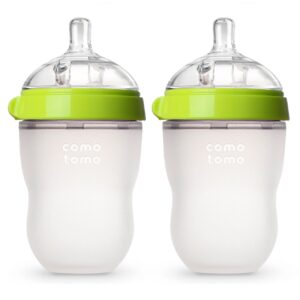
Comotomo bottles are often the first choice for babies who flat-out refuse traditional bottles. The wide, soft silicone nipple feels very close to breastfeeding, while the squeezable silicone body gives babies a familiar, comforting texture. The dual anti-colic vents help reduce gas without adding lots of extra parts to clean.
Pros:
- Ultra-soft, breast-like nipple that most babies accept
- Flexible, squeezable body mimics skin
- Easy to clean with wide opening
Cons:
- Pricier than standard bottles
- Can tip over more easily because of the wide base
Best for: Babies who refuse all other bottles and need something that feels like breastfeeding.
2. Philips Avent Natural – Best for Transitioning from Breast
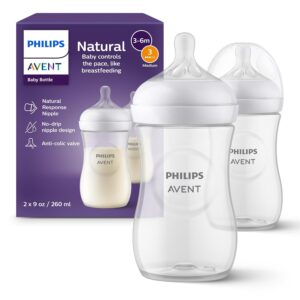
The Avent Natural line is one of the most popular worldwide because of its simple, effective design. The nipple is wide and breast-shaped, making it easier for babies to latch without confusion. Parents also love that it works with Avent breast pumps, which means less milk transferring.
Pros:
- Wide nipple designed for natural latch
- Compatible with Avent pumps and sterilizers
- Affordable and easy to find replacements
Cons:
- Some parents report nipple collapse if not assembled tightly
- Flow may be too fast if you don’t use the slowest nipple size
Best for: Parents who want an affordable, widely available option that babies adapt to quickly.
3. Dr. Brown’s Options+ Wide-Neck – Best for Colic and Gas
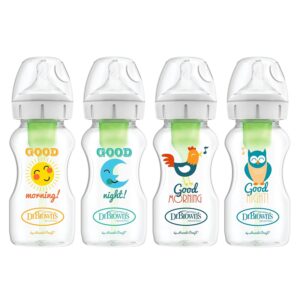
If gas, reflux, or colic are making feeding stressful, Dr. Brown’s is a trusted solution. The patented venting system is one of the best at reducing air bubbles and spit-up. While there are more pieces to wash, many parents say the payoff is worth it for a happier, more comfortable baby.
Pros:
- Excellent for reducing gas and reflux symptoms
- Wide-neck version better mimics breastfeeding latch
- Multiple flow levels available
Cons:
- More parts to clean than most bottles
- Slightly bulkier design for travel
Best for: Babies who struggle with colic, spit-up, or reflux and need a gentler feeding system.
4. Tommee Tippee Closer to Nature – Affordable Breast-Like Bottle
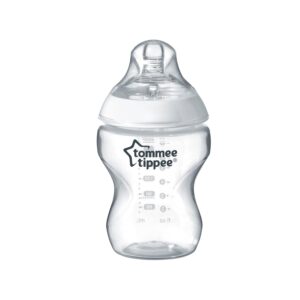
Tommee Tippee is a budget-friendly option that still does a great job of mimicking breastfeeding. The wide nipple is designed to stretch and flex, which helps babies latch more naturally. Parents often buy starter sets from this brand because they’re affordable and easy to replace.
Pros:
- Wide nipple helps with natural latch
- Easy-to-hold, compact design
- Very affordable compared to competitors
Cons:
- Nipples can wear out faster and may need replacing often
- Flow may vary slightly between bottles
Best for: Parents looking for an affordable breast-like bottle that’s easy to find in stores.
5. MAM Easy Start Anti-Colic Bottle – Best for Stubborn Refusers
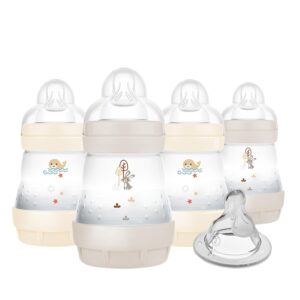
MAM bottles are a go-to when babies refuse everything else. The flat nipple design feels different from standard bottles and works well for babies who struggle with deep latch. The self-sterilizing base is also a huge time-saver if you don’t own a separate sterilizer.
Pros:
- Unique flat nipple helps picky babies accept the bottle
- Built-in venting system reduces colic
- Self-sterilizing design for quick cleaning
Cons:
- More parts than simpler bottles
- Some babies may prefer round nipples over flat
Best for: Babies who have rejected multiple bottles and parents who want built-in sterilizing convenience.
6. Nanobebe Flexy Silicone Bottle – Best for Pumping and Combo Feeding
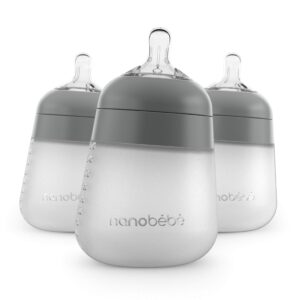
Designed with breastfeeding moms in mind, the Nanobebe Flexy Silicone bottle has a soft, breast-like nipple and flexible silicone body. It’s especially popular with pumping moms because Nanobebe also makes breast milk storage bottles that integrate with the system.
Pros:
- Soft silicone body and natural nipple feel familiar
- Wide, stable base prevents tipping
- Great option for pumping and bottle-feeding combo
Cons:
- On the pricier side
- Slightly bulkier for diaper bags
Best for: Parents who pump frequently and want a bottle designed for breast-to-bottle transitions.
7. Medela Breast Milk Bottle – Best for Pump Compatibility
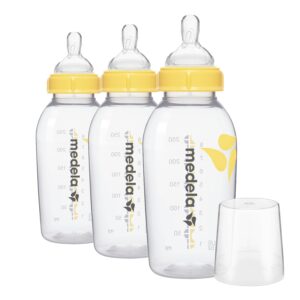
Medela is a household name for breast pumps, and their bottles are designed to work directly with them. This means you can pump, store, and feed all with the same bottle, reducing waste and saving time. The nipples are basic, but many babies adapt well to them.
Pros:
- Works seamlessly with Medela pumps
- Durable, simple design
- Affordable and sold in multi-packs
Cons:
- Not as “breast-like” as other bottles
- Limited flow options compared to competitors
Best for: Pumping parents who want fewer steps between pumping, storing, and feeding.
Detailed Comparison: Comotomo vs Tommee Tippee vs Philips Avent
When parents start searching for bottles that feel most like breastfeeding, three names come up again and again: Comotomo, Tommee Tippee, and Philips Avent. Each has its strengths, but the right choice depends on your baby’s preferences and your feeding priorities.
Quick Comparison Table
| Feature | Comotomo Baby Bottle | Tommee Tippee Closer to Nature | Philips Avent Natural |
|---|---|---|---|
| Nipple Design | Ultra-soft, wide, breast-like; flexible movement | Wide nipple; stretches and flexes | Wide breast-shaped nipple; firm but soft |
| Flow Options | Slow, medium, fast | Multiple flow levels | Wide range of flow options (newborn to fast) |
| Anti-Colic System | Dual anti-colic vents built into nipple | Basic venting | Airflex vent technology |
| Bottle Material | Soft silicone, squeezable | BPA-free plastic | BPA-free plastic |
| Ease of Cleaning | Very easy, wide opening, few parts | Easy, fewer parts | Easy, compatible with Avent sterilizers |
| Price Range | $$ (premium) | $ (budget-friendly) | $–$$ (mid-range) |
| Best For | Babies who reject all other bottles | Parents needing affordable starter sets | Smooth transition for breastfed babies |
Comotomo: Premium “Closest to Breast” Experience
Comotomo bottles shine for babies who simply won’t accept anything else. The soft, skin-like silicone body combined with an ultra-flexible nipple makes them the most natural-feeling option. The higher price is the trade-off, but for many parents, the relief of finally finding a bottle their baby accepts is worth every penny.
Choose Comotomo if: Your baby has refused multiple bottles and you want the most realistic breastfeeding alternative.
Tommee Tippee Closer to Nature: Best Budget-Friendly Breast-Like Bottle
Tommee Tippee offers a similar wide-nipple design at a much lower price point. While it may not have the same premium feel as Comotomo, many babies adapt well to it, especially in the newborn stage. Replacement parts are affordable and easy to find, making it a great starter choice.
Choose Tommee Tippee if: You want an affordable option that’s widely available and still mimics breastfeeding fairly well.
Read Next: Comotomo vs Tommee Tippee Bottles: Which One Feels Most Like Breastfeeding?
Philips Avent Natural: Most Balanced Option
Avent bottles are a favorite for their versatility. The wide nipple helps babies transition from breast to bottle, and the range of flow options means you can keep using them as your baby grows. They’re also compatible with Avent breast pumps, which makes life easier for pumping parents.
Choose Philips Avent if: You want a reliable, mid-priced bottle that works well for both newborns and older babies, with easy compatibility for accessories.
How to Introduce a Bottle to a Breastfed Baby (Tips for Success)
Even with the “best” bottle, some babies will still resist at first. The good news is that with patience and a few clever strategies, most babies do eventually make the switch. Here’s a step-by-step approach parents have found helpful:
Step 1: Pick the Right Timing
Try introducing a bottle after breastfeeding is well established (usually around 4–6 weeks), but not when your baby is extremely hungry or fussy. A calm, slightly hungry baby is more open to trying something new.
Step 2: Let Someone Else Offer the Bottle
Many babies won’t take a bottle from mom because they smell breast milk and expect to nurse. If possible, have a partner, grandparent, or caregiver offer the bottle while you step out of the room.
Step 3: Pay Attention to Milk Temperature
Babies who are used to breastfeeding may reject milk that feels cooler than body temperature. Warm the milk so it feels close to freshly expressed breast milk (around 98–100°F / 37–38°C).
Step 4: Mimic the Breastfeeding Position
Hold your baby in a semi-upright position, similar to breastfeeding. Some parents find that pacing the bottle — tilting it just enough so milk fills the nipple tip without gushing — helps babies feel more comfortable.
Step 5: Try Different Times of Day
Some babies are more willing in the morning when they’re rested, while others may do better in the evening when they’re winding down. A little trial and error can go a long way.
Step 6: Be Patient and Keep Trying
It’s normal for it to take several attempts before your baby accepts the bottle. Stay calm, avoid forcing it, and try again later if your baby becomes upset. Consistency is key.
Extra Tip: Some parents have success by dipping the nipple in a small amount of breast milk so the bottle smells and tastes familiar right away.
Read Next: Best Baby Bottle Gift Sets for Baby Showers
FAQs
What’s the best baby bottle if my breastfed baby refuses all bottles?
The Comotomo Baby Bottle is often the most successful with picky babies thanks to its soft silicone nipple and squeezable body that closely mimic breastfeeding. If Comotomo doesn’t work, many parents find success with MAM Easy Start Anti-Colic because of its unique flat nipple design.
How many bottles do I need if I’m breastfeeding?
If you’re mostly breastfeeding and only giving an occasional bottle, 3–4 bottles are usually enough. Parents who pump regularly often keep 6–8 bottles on hand to rotate between feeding, washing, and sterilizing.
Should I use glass or plastic bottles for breastfed babies?
Both work well — it depends on your lifestyle. Glass bottles are durable, eco-friendly, and easy to clean but heavier to carry. Plastic bottles are lighter and less breakable, making them more practical for on-the-go feeding. Just ensure they’re BPA-free.
How long does it take for a breastfed baby to accept a bottle?
It varies by baby. Some accept a bottle within a day or two, while others may take a few weeks of gentle, consistent attempts. Patience and persistence are key.
Do I need a bottle warmer for breastfed babies?
While not strictly necessary, many breastfed babies prefer milk at body temperature. A bottle warmer can make it easier to quickly heat milk to a consistent, baby-friendly temperature, especially for night feeds.
Checkout our list of Best Baby Bottles for Breastfed Babies Who Refuse the Bottle >
Conclusion: Finding the Right Bottle for Your Breastfed Baby
If your little one is refusing the bottle, you’re far from alone — it’s one of the most common feeding struggles parents face. The good news is that today’s baby bottles are designed with breastfeeding in mind, and there are excellent options that can make the transition much smoother.
For babies who are extremely picky, the Comotomo Baby Bottle often stands out because of its soft, breast-like design and flexibility. If gas or fussiness is your main challenge, the MAM Easy Start Anti-Colic or Dr. Brown’s Natural Flow are great solutions. Parents looking for a truly wide, breast-shaped nipple often find success with the Philips Avent Natural Response. And if you want a simple, budget-friendly option that still works well, the NUK Simply Natural is a reliable pick.
The key is patience and experimentation. No single bottle works for every baby, and sometimes it takes trying two or three before finding the one your baby finally accepts. Start with one highly recommended option, introduce it slowly (ideally when your baby is calm and hungry, but not overly fussy), and give yourself grace in the process.
Final Recommendation:
If you need a place to start, we suggest beginning with the Comotomo Baby Bottle for its proven track record with breastfed babies. Have a backup like MAM Easy Start Anti-Colic ready if your little one still resists.
Whichever bottle you choose, remember: what matters most is a happy, well-fed baby — and the right bottle can make feeding time calmer and more enjoyable for both of you.
